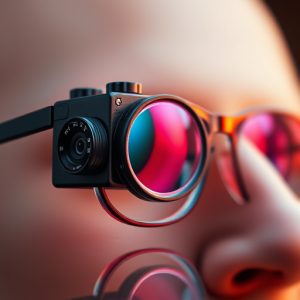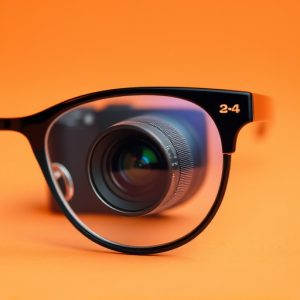Exploring the Functionality and Future of Glasses with a Camera Built In
Camera glasses have revolutionized personal media capture and vision correction by combining advance…….
Camera glasses have revolutionized personal media capture and vision correction by combining advanced recording technology with high-functionality vision aids. These devices are designed with ergonomic comfort and optoelectronic expertise, offering a hands-free, lightweight solution for capturing life's moments in top-tier video quality. They cater to a wide range of users, from professionals in journalism, real estate, and education who value their on-the-spot documentation capabilities, to individuals with vision needs who appreciate the dual benefit of clear sight and media recording. Over the past decade, these glasses have transitioned from niche AR applications to mainstream use due to advancements in miniaturizing camera and processor technology. They now serve multiple purposes, including AR information overlay, visual assistance, safety features for the visually impaired, and more. As the technology continues to innovate, we can expect further improvements in user interfaces, making glasses with a camera built in an integral part of everyday life. When selecting these smart glasses, it's important to consider high-resolution displays, wide field of view, compatibility across operating systems, long battery life, connectivity options like Bluetooth and Wi-Fi, stabilization features, privacy filters, and ergonomic design for comfort and practicality. They are already transforming various sectors by enabling seamless recording and enhancing professional practices like real estate virtual tours and medical documentation. The future of these camera-equipped glasses is bright, with potential integrations with AI for features like language translation and improved image stabilization, further blurring the lines between the physical and digital worlds.
delve into the transformative landscape of wearable technology, this article sheds light on the multifaceted world of camera glasses. Explore the intricate blend of visual enhancement and recording capabilities as we traverse their origins, key functionalities, and the myriad ways they enhance our daily lives. From the early days of glasses with a camera built in to the cutting-edge models poised to redefine personal media capture, this journey through innovation will offer insights into the current state and future prospects of this tech-laden eyewear revolution.
Understanding Camera Glasses: A Fusion of Vision and Recording Technology
Camera glasses have revolutionized the way individuals capture and view the world around them, merging advanced vision correction with state-of-the-art recording technology. These innovative devices are equipped with miniature cameras built directly into the frames, allowing wearers to seamlessly transition between seeing and filming their environment. The integration of these components necessitates a deep understanding of ergonomics and optoelectronics; the glasses must be lightweight and comfortable for extended wear while also housing intricate camera mechanisms that deliver high-quality visual outputs.
The practicality of glasses with a camera built in cannot be overstated, as they offer a hands-free, immersive recording experience. Users can document their daily lives without the need for separate devices or cumbersome equipment. This technology is particularly beneficial for professionals in fields such as journalism, real estate, and education, where capturing visual content on the fly is essential. Additionally, for individuals with vision impairments who rely on glasses, these camera-equipped devices provide a dual function that enhances their ability to both see clearly and document their experiences, making them an invaluable tool for a wide range of users.
The Evolution of Glasses with Built-In Cameras: From Concept to Reality
The concept of integrating cameras into eyewear has evolved significantly over the past decade, transforming from a futuristic idea into a practical reality. Initially, glasses with a camera built in were the domain of niche markets and early adopters, who were intrigued by the potential applications of such technology. These early models focused on augmented reality (AR) and provided rudimentary capabilities for overlaying digital information onto the real world. As technology advanced, the miniaturization of cameras and processors made it feasible to embed these components into the frames of glasses more compactly and efficiently. This progression led to the development of smart glasses that could capture images and video with a level of quality once thought unattainable in such a form factor.
Today, glasses with a camera built in are at the forefront of consumer electronics innovation, offering a plethora of features. They assist individuals in capturing life’s moments, accessing information through AR, enhancing visual experiences, and even providing additional safety measures like object recognition to aid visually impaired users. The integration of cameras into glasses has also been embraced by various industries, including healthcare, education, and professional sectors, where the ability to record or view content without holding a separate device is invaluable. As the technology continues to mature, we can anticipate even more sophisticated applications and improvements in user interface design, making glasses with a camera built in an increasingly integral part of our daily lives.
Key Features to Look for in Camera Glasses
When exploring options for glasses with a camera built in, it’s crucial to focus on several key features that enhance both the functionality and the user experience. Firstly, resolution is paramount; higher pixel density translates to crisper images and videos, which is essential for capturing details clearly. The field of view should also be considered, as a wider angle allows for more context in each frame, making your recordings more comprehensive. Additionally, the camera’s compatibility with various operating systems and storage solutions ensures that users can easily manage their media across devices. Battery life is another critical aspect; glasses with removable batteries or high-capacity power sources can significantly reduce the frequency of recharging.
Another key feature is the camera’s connectivity options, particularly Bluetooth and Wi-Fi capabilities, which facilitate direct transfer of media to smartphones or computers. Image stabilization is equally important for avoiding shaky footage, especially if the user is active or moving at the time of recording. Privacy filters can be a valuable addition, providing a layer of security by preventing unwanted camera activation or recording. Lastly, the design and comfort of the glasses themselves should not be overlooked; durable yet lightweight materials contribute to all-day wearability, making these devices both practical and comfortable for extended use. By carefully evaluating these features, users can select the best glasses with a camera built in to suit their specific needs and preferences.
Practical Applications of Glasses with a Camera Built In
Glasses equipped with cameras have become increasingly sophisticated, offering practical applications across various fields. In the realm of personal technology, these devices enable users to capture moments and images hands-free, seamlessly integrating into daily life. For instance, individuals can record their day-to-day experiences without the need for a separate camera, making it easier to document life’s precious moments. These glasses are particularly beneficial for individuals engaged in activities where carrying a camera is impractical or where capturing images covertly is necessary. They offer unobtrusive recording capabilities, ideal for professionals like journalists who wish to record events without drawing attention.
Moreover, the integration of cameras into eyewear has significant implications for professional settings. In fields such as real estate, agents can provide immersive virtual tours by capturing high-quality panoramic images of properties, allowing potential buyers to explore spaces remotely. The medical industry also stands to gain, with clinicians using these glasses to document procedures or patient interactions, enhancing record-keeping and providing a visual aid for diagnosis or postoperative follow-ups. The technology behind glasses with a camera built in continues to advance, ensuring high-resolution imagery and user-friendly functionality that will further expand their practical applications in both professional and personal contexts.
The Future of Camera Glasses: Innovations and Predictions
The integration of cameras into eyewear has seen significant advancements, positioning glasses with a camera built in as a promising technology for the future. These devices are becoming increasingly sophisticated, offering users the ability to capture images and videos with greater ease and discretion than traditional handheld cameras. As we look ahead, the potential applications for these camera-equipped glasses are vast, ranging from augmented reality (AR) experiences to advanced security measures. For instance, AR can overlay digital information onto the real world, enhancing the way users interact with their environment. Moreover, the security sector is exploring the use of these devices for facial recognition and identification, offering a new layer of safety and convenience.
Innovations in this space are not limited to functionality; they also encompass improvements in design and user experience. Manufacturers are working on making these glasses more stylish and comfortable, ensuring they blend seamlessly into everyday life. The miniaturization of camera components allows for sleeker frames without compromising on image quality. Additionally, the integration of artificial intelligence (AI) is expected to enhance the utility of glasses with a camera built in, enabling features like real-time language translation and improved image stabilization. As these technologies mature, they will undoubtedly change how we capture and interact with media, offering new perspectives on both personal and professional communication and content creation. The future of camera glasses is poised to merge the digital and physical worlds in ways that are currently limited only by our imagination.


